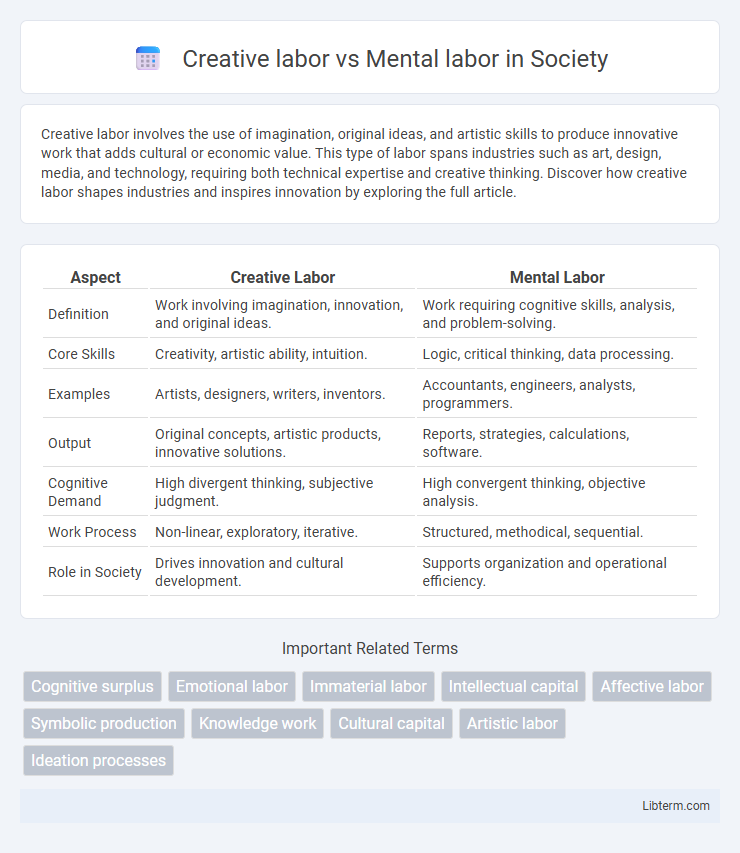Creative labor involves the use of imagination, original ideas, and artistic skills to produce innovative work that adds cultural or economic value. This type of labor spans industries such as art, design, media, and technology, requiring both technical expertise and creative thinking. Discover how creative labor shapes industries and inspires innovation by exploring the full article.
Table of Comparison
| Aspect | Creative Labor | Mental Labor |
|---|---|---|
| Definition | Work involving imagination, innovation, and original ideas. | Work requiring cognitive skills, analysis, and problem-solving. |
| Core Skills | Creativity, artistic ability, intuition. | Logic, critical thinking, data processing. |
| Examples | Artists, designers, writers, inventors. | Accountants, engineers, analysts, programmers. |
| Output | Original concepts, artistic products, innovative solutions. | Reports, strategies, calculations, software. |
| Cognitive Demand | High divergent thinking, subjective judgment. | High convergent thinking, objective analysis. |
| Work Process | Non-linear, exploratory, iterative. | Structured, methodical, sequential. |
| Role in Society | Drives innovation and cultural development. | Supports organization and operational efficiency. |
Understanding Creative Labor and Mental Labor
Creative labor involves the generation of original ideas, innovation, and artistic expression, relying heavily on cognitive flexibility, imagination, and problem-solving skills. Mental labor encompasses tasks requiring sustained attention, memory, planning, and mental organization, often linked to decision-making and managing complex information. Understanding the distinction highlights how creative labor drives innovation and cultural production, while mental labor ensures effective execution and management within intellectual and professional contexts.
Defining the Core Differences
Creative labor involves generating original ideas, artistic expression, and innovative problem-solving, relying heavily on imagination and cognitive flexibility. Mental labor centers on cognitive tasks such as planning, organizing, decision-making, and managing information, emphasizing structured thinking and analytical skills. The core difference lies in creative labor's emphasis on producing novel concepts, whereas mental labor prioritizes controlling and processing existing knowledge.
Historical Evolution of Work Types
Creative labor historically evolved from artisanal craftsmanship during the Renaissance, emphasizing innovation and unique skillsets, while mental labor gained prominence with the Industrial Revolution's shift toward clerical and administrative tasks in large organizations. The 20th century saw a further divergence, where creative labor integrated multidisciplinary knowledge in fields like advertising and design, contrasting with mental labor's focus on data processing and routine problem-solving in bureaucratic systems. Digital transformation now blurs these distinctions, as both labor types increasingly rely on cognitive skills and technological tools to drive productivity and innovation.
Skills Required for Creative vs. Mental Tasks
Creative labor requires skills such as originality, imagination, and innovative problem-solving, emphasizing the generation of novel ideas and artistic expression. Mental labor demands analytical thinking, concentration, and logical reasoning, focusing on tasks like data analysis, decision-making, and information processing. Both types of labor involve cognitive effort but differ in skill emphasis, with creative tasks prioritizing divergent thinking and mental tasks relying on convergent thinking.
The Role of Innovation in Creative Labor
Creative labor drives economic growth through continuous innovation, leveraging originality and imaginative problem-solving to develop new products, services, and artistic expressions. Innovation in creative labor enhances competitive advantage by fostering novel ideas that disrupt traditional processes and generate unique market value. This dynamic interplay between creativity and innovation is essential for industries such as technology, design, and media, where intellectual capital is a core asset.
Measuring Productivity in Mental and Creative Roles
Measuring productivity in mental and creative roles requires evaluating output beyond quantitative metrics, focusing on originality, problem-solving, and innovation. Unlike repetitive tasks, creative labor involves cognitive processes like idea generation and conceptual thinking, which demand qualitative assessment tools such as peer reviews and portfolio evaluations. Mental labor productivity benefits from tracking progress through milestone achievements and subjective impact analysis rather than traditional time-based measurements.
Impact on Job Satisfaction and Motivation
Creative labor, involving innovation and problem-solving, significantly enhances job satisfaction by fostering autonomy and intrinsic motivation, as employees feel a sense of purpose and accomplishment. Mental labor, which includes cognitive tasks like planning and analyzing, can also boost motivation but may lead to higher cognitive load and stress if not balanced with variety or autonomy. Organizations that effectively integrate creative challenges with manageable mental tasks tend to experience higher employee engagement and sustained motivation.
Technological Influence on Both Labor Types
Technological advancements have significantly transformed both creative and mental labor by automating routine tasks and enhancing complex problem-solving capabilities through AI and machine learning. Creative labor now integrates digital tools like graphic design software and virtual reality to expand artistic expression, while mental labor benefits from data analytics and cognitive computing that improve decision-making efficiency. This convergence increases productivity but also demands continual skill adaptation to leverage evolving technologies effectively.
Challenges and Opportunities in the Modern Workforce
Creative labor in the modern workforce demands innovative thinking and emotional intelligence, presenting challenges such as burnout and subjective performance metrics. Mental labor involves cognitive tasks like planning and problem-solving, often accompanied by invisible stress and undervaluation. Opportunities arise from integrating digital tools and fostering collaborative environments that enhance productivity and employee well-being.
The Future Outlook: Balancing Creative and Mental Labor
The future outlook of work emphasizes balancing creative labor, which involves innovation and original thinking, with mental labor, characterized by analytical and cognitive tasks. Advances in artificial intelligence and automation are reshaping roles, increasing the demand for creative skills that AI cannot easily replicate while also enhancing mental labor efficiency. Organizations must foster environments that integrate both types of labor to drive productivity and adapt to evolving workforce needs.
Creative labor Infographic

 libterm.com
libterm.com